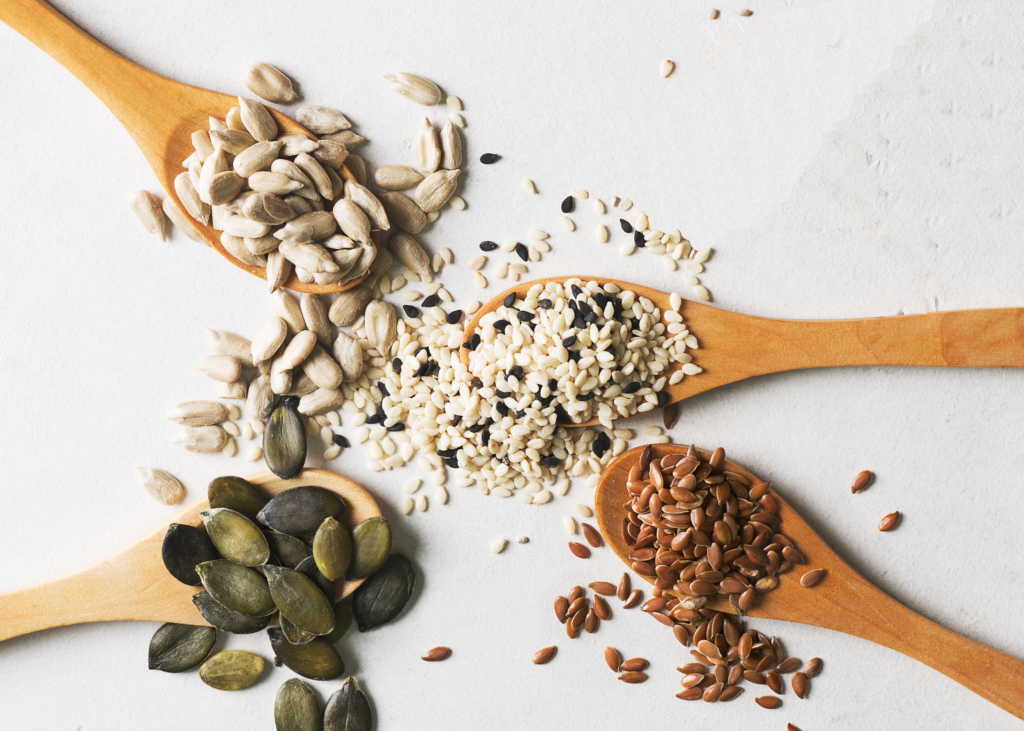Can Seed Cycling Ease Menstrual Cycle Complications and Symptoms?
Clinical Consulting Team
Can Seed Cycling Ease Menstrual Cycle Complications and Symptoms?
by Clinical Consulting Team
This post was updated with new research in January 2023.
Many healthcare providers look to DUTCH testing to help diagnose their female patients experiencing issues with their menstrual cycle and symptoms such as irregular or absent periods, painful periods, moodiness in the week prior to the period, menstrual migraines, and more. These symptoms are common and disruptive to daily living. Once practitioners have used DUTCH to identify hormone imbalances, the next step is proper and individualized treatment. A very gentle, nutritional support practice is called “Seed Cycling.”
What is Seed Cycling?
Seed cycling is the practice of consuming specific seeds in a cycle which follows the woman’s menstrual cycle, or in two week “phases.” During the follicular phase, a female patient consumes ground flax and pumpkin seeds, and during the luteal phase she consumes ground sesame and sunflower seeds.
If a woman does not have a cycle to follow, she takes the seeds in a similar biphasic fashion throughout the course of a month. Choosing a start and stop date for each phase may be arbitrary when cycles are absent, but many women choose to use the phases of the moon; starting the follicular seed phase on the new moon and the luteal seed phase with the full moon. Moon phases are commonly noted on calendars to remind the patient when to start the next phase.

How does Seed Cycling work?
There are several research-backed reasons why seed cycling might work for some women:
- Beneficial Omega-6 fatty acids, more specifically linoleic acid, are found in seeds.
This fatty acid converts into GLA and DGLA which help build prostaglandins and is essential for ovulation. Essential fatty acids also work on anti-inflammatory pathways which lowers inflammation and symptoms of cramping, fatigue, and moodiness. A deficit of PGE1 or products of Omega 3/6 fatty acids contributes to menstrual irregularity, menstrual cramps, premenstrual dysphoria, and moodiness. Excess of pro-inflammatory PGE2, which competes with PGE1, may also cause these issues. In either case, tipping the dietary balance towards PGE1 by taking seeds may help. - Seeds provide phyto-estrogenic lignans.
Phyto-estrogenic lignans can act at the level of estrogen receptors, providing weak stimulation and possibly blocking stronger estrogens or xenoestrogens and balancing low or high receptor activity. Excessive or deficient estrogen activity is a common cause of irregular periods, heavy bleeding, and PMS symptoms. Flaxseed and sunflower seeds, specifically, provide the most phyto-estrogenic lignan content. Flaxseed consumption has been shown to reduce anovulatory cycles and improve progesterone production by increasing ovulation regularity. Flaxseeds may slightly increase the length of the luteal phase, which is often seen as reflecting healthier progesterone levels. Flax is also beneficial in inducing CYP1A1 healthy phase 1 estrogen detox. - Flax, pumpkin, sesame, and sunflower seeds contain hormone-balancing nutrients.
In addition to providing EFAs and lignans, the seeds used in seed cycling are great sources of the following hormone balance promoting nutrients:
Zinc
Pumpkin, sunflower, and flaxseeds are great sources of zinc, a nutrient necessary for ovulation by promoting follicle stimulating and luteinizing hormone release. Zinc may also reduce menstrual cramps.
Selenium
Sunflower seeds are rich in selenium, which helps with liver detox of hormones.
Vitamin E
Fatty seeds are naturally good sources of vitamin E, a nutrient shown by studies to improve ovulation and progesterone production. Progesterone is a balancing hormone which helps mitigate negative effects of too much estrogen.
Fiber
Seeds contain plenty of fiber which can help bind and remove toxins and hormones from the GI tract as well as regulate insulin. Improving fiber intake can also reduce estrogen levels in cycling women.
In conclusion, symptoms such as cramps, mood disturbances, irregular periods, and absent periods may be alleviated by seed cycling. These symptoms may become evident with low progesterone, lack of ovulation, low or high estrogen, or poor estrogen metabolism. Seed cycling adds important sources of EFAs and lignans, balances inflammation, and gives phytoestrogen support.
Supplementation and Testing
Ground seeds can be added to smoothies, salads, soups, and oatmeal.
- During follicular phase: consume 1-2 tablespoons of ground flax and pumpkin seeds.
- In luteal phase: consume 1-2 tablespoons of ground sesame and sunflower seeds.
This therapy might show the most benefits for patients with essential fatty acids deficiencies from dietary restrictions or liver or GI issues.
Consider combining ground seeds with 3-4g of EPO and 1-2g of fish oil 1-2g throughout the month for additional inflammation and mood support, among other health benefits.
When testing with DUTCH, look for imbalances of estrogen and progesterone or lack of ovulation as fluctuating levels of estradiol and progesterone play a major role in a woman’s overall health. Consider using the DUTCH Cycle Mapping and Cycle Mapping™ Plus panels, which map the progesterone and estrogen patterns throughout the menstrual cycle. Both panels provide the full picture of a woman’s cycle to answer important questions for patients with month-long symptoms, infertility, or PCOS.
References
- Abraham, G.E., Nutritional factors in the etiology of the premenstrual tension syndromes. J Reprod Med, 1983. 28 (7): p. 446-64.
- Coulman, K.D., et al., Whole sesame seed is as rich a source of mammalian lignan precursors as whole flaxseed. Nutr Cancer, 2005. 52 (2): p. 156-65.
- Harel, Z., et al., Supplementation with omega-3 polyunsaturated fatty acids in the management of dysmenorrhea in adolescents. Am J Obstet Gynecol, 1996. 174 (4): p. 1335-8.
- Koshikawa, N., et al., Prostaglandins and premenstrual syndrome. Prostaglandins Leukot Essent Fatty Acids, 1992. 45 (1): p. 33-6.
- Puolakka, J., et al., Biochemical and clinical effects of treating the premenstrual syndrome with prostaglandin synthesis precursors. J Reprod Med, 1985. 30 (3): p. 149-53.
TAGS
Ovulation
Menstrual Cycle
Female Fertility
Estrogen and Progesterone
Premenopausal Women
Women's Health
Fertility